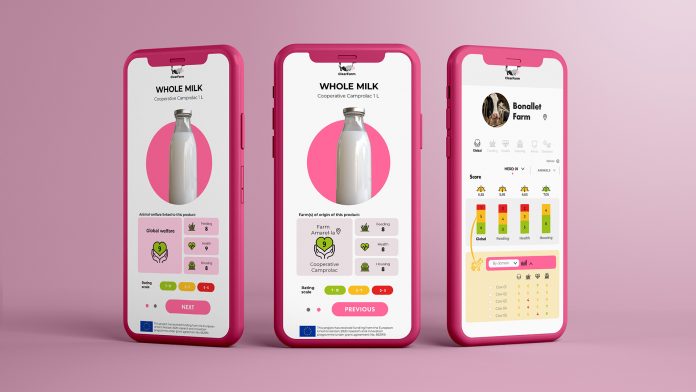The ClearFarm project uses sensor and deep learning technologies to effectively assess the welfare of farm animals throughout the value chain.
Picture yourself in a supermarket. You head to the dairy or meat section and see a colour code displaying an ‘animal welfare score’ on every item. This score provides information on animal welfare when this animal produced this product.
Now imagine a farmer who can keep tabs on their animals throughout their lives via electronic devices, receiving real-time updates and notifications on herd welfare and making timely adjustments to their herd management and practices.
Sensor technology and Artificial Intelligence (AI) for monitoring farm animals have made great strides in recent years and are increasingly used in livestock farming. Additionally, the pressure in Europe to boost animal welfare on farms is mounting. The previously mentioned scenarios are the envisioned goals of the ClearFarm project – create a platform for producers and consumers to monitor animal welfare information in pigs and dairy cows using sensor technology.
The ClearFarm project
The ClearFarm platform has been designed to collect welfare and environmental impact information from dairy cattle and pigs on the farm and transmit it to cloud servers for analysis. The platform caters to farmers and consumers to enhance farm animal welfare, sustainability assessments, and consumer product selections. It uses continuous sensor data from accelerometry collars and rumen boluses to monitor dairy cows. Additional reference data is derived from veterinary records and traditional welfare assessments, such as the Welfare Quality® protocol.
ClearFarm adopts the five domains model of animal welfare assessment, which breaks down animal welfare into five domains (nutrition, housing, health, behavioural interactions and mental state). Building on this approach, we evaluated how the parameters recorded by the sensors contribute to the assessment of specific welfare indicators for each domain. For example, the time a dairy cow spends feeding and ruminating each day, frequency of feeding, how often she drinks each day, and rumen temperature, are all parameters that sensors can measure to provide nutrition information.
Reviews of commercially available sensors with validated performance have led to the conclusion that it is currently possible to monitor the dairy cow welfare, including health, nutrition, and housing, using daily sensor data.
Labelling, regulations, and environmental impact
Animal welfare is an attribute of food quality, and EU citizens want more information on how farmed animals are treated. Product labelling can help raise consumer awareness of food quality and sustainability while supporting EU producers who meet high welfare standards. ClearFarm has reviewed various animal welfare labels and found that many use resource-based measures rather than animal-based models. Animal welfare labelling is governed by EU legislation, which emphasises accurate and verifiable claims. Key factors for successful labelling include industry participation, consumer awareness, transparency, and multi-stakeholder involvement. Digitalisation and innovative technologies offer opportunities to improve communication with consumers.
EU Regulation 1169/2011 establishes mandatory and voluntary elements for food labelling. Animal welfare information is voluntary, leading to different national labelling schemes that can confuse consumers. We address this with a software platform that collects and integrates animal welfare data from sensors, displaying it to producers and consumers for informed decision-making. It ensures compliance and builds confidence through scientific analysis based on animal-based measurements. This technology increases transparency and minimises the risk of misleading information, in line with European voluntary food labelling regulations.
The environmental impact of livestock production is an important factor in farm animal welfare. ClearFarm used the standardised life cycle assessment (LCA) methodology (ISO 14040) to assess the environmental impacts of products, processes, or services. When applied to pig and dairy farming systems, LCA assesses their impact on global warming, land use, eutrophication, acidification, water use, and other factors. This helps to identify key pollution or resource consumption stages and strategies for improvement. LCA defines system boundaries and assesses animal products and by-products like butter, cheese, and meat. Clearfarm aims to link LCA results to animal welfare and the environment to create a platform that embeds both.
The challenges in animal welfare assessment
Although the need for farm animal welfare is widely accepted as essential for sustainable agriculture, its continuous assessment remains a challenge. Precision livestock farming (PLF) is the use of advanced technologies such as sensors that can monitor a wide range of variables of interest to animal welfare, environmental impact, and productivity. These sensors track various aspects of animal behaviour, enabling real-time monitoring and rapid response to welfare issues. PLF generates large amounts of data that can benefit farmers, retailers, and consumers, but better integration of welfare aspects is needed.
Animal welfare assessment traditionally depends on pen-level data, but we emphasise the need for individual-level information. By studying individual animal behaviour and routine differences, we gain crucial insights. Our studies have shown variation in daily feeding rhythms between pigs, with consistent strategies in terms of meal frequency, speed, night-time eating and feeding schedules. These differences allow the detection of deviations from normal behaviour, especially regarding welfare issues such as lameness. The project aims to improve the accuracy of welfare monitoring by modelling individual animal behaviour to identify unusual patterns.
ClearFarm strategies: Machine Learning
Machine Learning (ML) is used in ClearFarm to extract valuable insights from the data collected using PLF technologies. ML models, trained with vet assessments and farm records, predict the likelihood of animal disease and enable early warning. For example, ClearFarm has developed predictive models for acidosis and mastitis to anticipate disease and promote corrective action.
ML models require sensor data to be split into training, validation, and test sets:
• The aim of the training is to reduce the gap between the predicted and actual outcomes in the training data set.
• The model’s performance is evaluated on the validation set until the prediction score (accuracy) is acceptable, typically between 70-80%.
• The test set is used to evaluate the model’s true predictive capability with data that was not seen during training.
Predicting mastitis and acidosis
Mastitis, a common disease in dairy cows, is a multifactorial disease usually caused by a bacterial infection that leads to mammary gland inflammation. It has a significant impact on economic and animal welfare. Depending on severity, mastitis can be subclinical or clinical. In clinical cases, there are obvious symptoms such as changes in the milk (consistency, reduced yield, presence of somatic cells and bacteria making it unfit for human consumption), visible changes in the mammary gland (swelling, pain, redness), and changes in behaviour.
ClearFarm’s ML models for mastitis detection uses predictive variables such as milk conductivity and somatic cell count: as somatic cell count increases, so does milk conductivity. If a cow produces milk with a conductivity greater than 5.5 mS/cm, it is a potential case of mastitis.
Acidosis, a common metabolic disorder in dairy cows, occurs when the pH balance in the rumen becomes excessively acidic, which can have serious consequences for the cow’s health and productivity. It can produce diarrhoea, lameness, and reduce appetite and milk production. It also disrupts the balance of beneficial rumen micro-organisms, leading to further digestive problems. A cow with a ruminal pH below ~5.8 is a potential acidosis case. Therefore, the predictive variable for acidosis in ClearFarm’s ML model was ruminal pH, continuously recorded by a rumen bolus (Smaxtec, Vienna, Austria), a sensor in the cow’s rumen.
These models show excellent performance in identifying potential cases of mastitis and acidosis, providing near real-time feedback. The models are currently being fine-tuned to improve their accuracy. Most of the few errors detected for both conditions produced occasional false alarms, rather than missing disease cases, and were of low probability, alerting to cases slightly above the threshold.
The platform
The farmer interface displays daily welfare scores for individual cows in three welfare areas (housing, nutrition, and health), along with an overall score. A traffic light colour scheme indicates cow welfare, red to indicate a high welfare risk and green indicating good welfare, allowing farmers to set alerts if scores fall below a certain threshold. The interface also shows the likelihood of individual animals suffering from mastitis and acidosis.
The consumer interface allows consumers to access animal welfare scores and the overall score using their mobile phone. This information helps consumers make informed choices about products from farms that prioritise animal welfare and enables them to check the welfare status of the animals.
Additional findings
In pigs, play behaviour and activity levels were analysed as indicators of welfare. The results suggest that play behaviour can be a valuable welfare indicator, particularly in the context of early weaning, and can contribute to on-farm welfare assessment protocols.
Research has shown that activity levels in pigs can vary considerably due to events such as leg injuries (lameness), disease or stress. In addition, spatial distribution and posture can indicate behavioural patterns during the day, including resting and feeding habits and comfort when resting in the pen.
Results showed good agreement between sensor data and human observations for spatial distribution and posture, but challenges in validating activity level data. Nevertheless, there are correlations between environmental changes and pig welfare, suggesting that sensor-based activity levels may be useful for welfare monitoring.
In dairy cows, ClearFarm’s trials and literature review have identified certain behavioural patterns that change when the animal has mastitis. Changes in eating, drinking, ruminating and resting behaviour can provide an early detection system for mastitis before it becomes clinical.
Cows with mastitis significantly reduced their ruminating time four days before diagnosis. This early detection can reduce the impact on animal welfare, treatment costs and replacement rates. The team also investigated the potential of some behavioural indicators recorded by accelerometry collars for early detection of acidosis. A significant reduction in rumination time can predict a drop in ruminal pH one day in advance.
A living platform
The ClearFarm project is almost complete. We have successfully used sensor data to create an online platform for continuous monitoring of animal welfare. However, further research is needed to address gaps in understanding, such as the development of sensors to measure animal welfare across different domains.
PLF sensors currently in development or available on the market are mostly focused on the health domain, resulting in unbalanced algorithms for assessing animal welfare. ClearFarm’s concept relies on sensor data to monitor animal welfare and provide early warning signals. It is a living platform with flexible algorithms, ready to be enriched with validated and constructive evidence from more advanced precision livestock technologies soon.
Please note, this article will also appear in the sixteenth edition of our quarterly publication.










